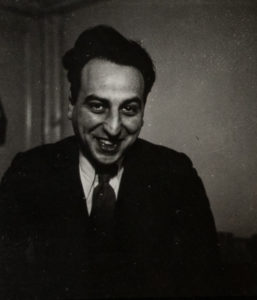Blog
Carel van Lier and Erwin Blumenfeld, portrait of a friendship.
Bas van Lier - 2023
Erwin Blumenfeld’s first exhibition of his photographs, in May 1932 at Kunstzaal Van Lier in Amsterdam, is considered to be the very first exhibition of photographs in an art gallery in the Netherlands. The gallerist, Carel van Lier (1897-1945), my grandfather, was known for his progressive taste in art, bringing the public the avant-garde artists of the time. From the start, in 1924, he also pioneered with the presentation of ethnographic art from Africa, Asia and Oceania. In 1927 his collection of over 150 pieces featured in an exhibition at Stedelijk Museum in Amsterdam, which was the first tribal arts exhibition in a museum for modern arts in the Netherlands.
It is most likely that Blumenfeld and Van Lier got to know each other through their mutual friend Paul Citroen. Citroen worked together with Van Lier on his book ‘Palet’ (1930) and would have introduced his cousin’s husband to the art dealer (Erwin Blumenfeld was married to Lena Citroen, Paul’s first cousin). They must have recognized each other’s interest in new avenues in art and as their shops, Blumenfeld’s Fox Leather Company and Van Lier’s Kunstzaal, were close by, it is quite conceivable that the two saw each other on a regular basis.
Experiments
When Blumenfeld started experimenting with photography, my grandfather must have been intrigued as he recognized the work’s artistic quality. Considering photography as an art form was a novelty at the time. Photography was still mainly just seen as a representation of reality and more of a technical skill than an artistic expression. But international developments in the field, must have raised my grandfather’s interest and in 1932 he felt the time was ripe to confront the audience with Blumenfeld’s view of the world.
Just one image of this first installation remains in Blumenfeld’s contact sheets of the time. It shows a corner of the big exhibition room on the first floor of the gallery. On the walls several larger prints are combined with smaller ones in a carefully arranged composition. More pictures are placed on a table in the room. Interestingly, the three large prints, two street scenes and a view from a window in Paris, seem to be mounted on a panel without a frame. The smaller prints, closeups of faces, details of architectural ornaments, photographic experiments and a view from above on the roofs of Amsterdam, seem to be framed.
The reception of the exhibition in the press was quite reserved, but this didn’t withhold my grandfather to stage another exhibition, two years later, called ‘Cinquante têtes de femmes’. It featured a wall filled with 50 closeups of women Blumenfeld had made in the previous years. Among them family, friends, famed actors and artists, as well as passers-by who visited his leather shop.
Meanwhile, probably out of fun, Blumenfeld made a series of photographs in my grandfather’s gallery, portraying him, his assistant Leni Spoor, as well as artists and probably clients. Blumenfeld also made several interior shots, that were a great help for me when I wrote my book on my grandfather and his gallery (Carel van Lier, kunsthandelaar en wegbereider, 1897-1945, Bussum, 2003). These pictures gave me an impression of what the gallery had looked like. Blumenfeld also helped my grandfather with the production of a company postcard, for which he made a collage of different art works representing the variety of things of beauty on offer.
A Twinkle
The portraits of my grandfather give away the fun the two must have had in making them. They played with a skeleton my grandfather kept in his shop, which resulted in an iconic double print of the gallerist and this skeleton. There is also a series of four portraits in which my grandfather holds an elephant tusk, of which he had several in his collection. Amazingly, these pictures helped me reclaiming the tusk, that in 1941 was sold to the Ethnology Museum of Frankfurt, and after being recuperated after WWII ended up in the Dutch National Collection. Blumenfeld’s picture proved that the tusk had been part of my grandfather’s collection.
I have known for a long time most of Blumenfeld’s portraits of my grandfather. But in 2018, when I was given the chance to see all of the photographer’s contact sheets from his Amsterdam period, I discovered there were several more and also several pictures of my aunt, Van Lier’s eldest daughter. She once told me that when she was portrayed at the age of seven or eight years old, she had been a little frightened of this strange photographer. The pictures indeed seem to reveal this.
But Carel van Lier appears to have had lots of fun with Erwin Blumenfeld, and one of the most moving discoveries the contact sheets brought me, was the only picture I know of my grandfather laughing. His life was full of hardships, but here we see a happy man with a twinkle in his eyes. It’s a precious gift to me from the past.

